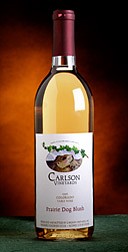 |
|
Wine Details
Price:
$8.99 per bottle
Description:
This favorite, fruity, slightly sweet blush wine is made of a blend of 100% Colorado Grown Riesling, Seyval, Muscat, Chardonel, and Merlot grapes. It is easy to enjoy by itself or accompanying fowl, fish, or cheese, and is best served chilled. More flavorful than White Zinfandel. Prairie Dog Blush is the largest selling Colorado Grown Blush Wine.
|
|
|